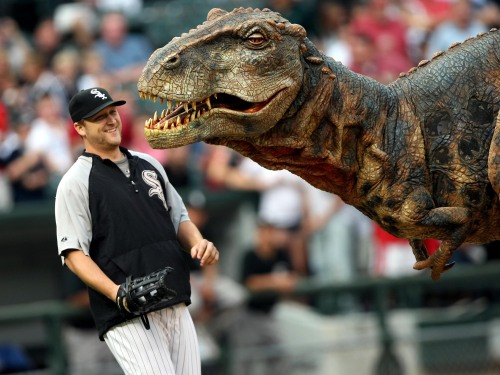Some dinosaurs may have been on the way to extinction millions of years before an asteroid hit the Earth 65 million years ago, U.S. researchers say.
 |
Chicago White Sox pitcher Mark Buerhle has a chuckle with robotic "Baby T Rex," who threw out the first pitch before the game against the Detroit Tigers at at U.S. Cellular Field in Chicago, Illinois, Wednesday, August 6, 2008. (MCT) |
Scientists say their findings show that large herbivores -- plant-eating dinosaurs -- had been declining for 12 million years before the asteroid hit at the end of the Cretaceous period, although carnivorous dinosaurs and smaller plant-eating species were not, a release from the American Museum of Natural History reported Tuesday.
"Few issues in the history of paleontology have fueled as much research and popular fascination as the extinction of non-avian dinosaurs," said Steve Brusatte of the museum's Division of Paleontology.
"Did sudden volcanic eruptions or an asteroid impact strike down dinosaurs during their prime? We found that it was probably much more complex than that, and maybe not the sudden catastrophe that is often portrayed."
U.S. and European researchers looked at dinosaur extinction based on "morphological disparity" -- the variability of body structure within particular groups of dinosaurs -- whereas previous research was based almost exclusively on estimates of changes in the number of dinosaur species over time.
Dinosaur groups that showed an increase in variability might have been evolving into more species, giving them an ecological edge, researchers said, while decreasing variability might be a sign of extinction in the long term.
"People often think of dinosaurs as being monolithic -- we say 'The dinosaurs did this, and the dinosaurs did that,'" Richard Butler of Ludwig Maximilian University of Munich said. "But dinosaurs were hugely diverse. There were hundreds of species living in the Late Cretaceous, and these differed enormously in diet, shape, and size. Different groups were probably evolving in different ways and the results of our study show that very clearly."
The findings suggest several groups of large-bodied, bulk-feeding herbivores may have experienced a decline in biodiversity in the 12 million years before the dinosaurs ultimately went extinct, the researchers said.
"Contrary to how things are often perceived, the Late Cretaceous wasn't a static 'lost world' that was violently interrupted by an asteroid impact," Brusatte said. "Some dinosaurs were undergoing dramatic changes during this time, and the large herbivores seem to have been mired in a long-term decline, at least in North America." (UPI)
<관련 한글 기사>
공룡들 멸종한 진짜 이유는?
공룡들이 멸종한 이유가 기존에 알려진 것처럼 운석 충돌 때문만은 아닐 수도 있다는 연구결과가 나왔다.
약 2억 3천만년전에 나타나 2억년 가까운 시간동안 번성했던 공룡이 전부 멸종한 이유는 명확하게 밝혀지지는 않았으나, 백악기 말에 지구를 강타한 운석 때문일 것이라는 설이 유력하다.
그러나 미국자연사박물관이 1일(현지시간) 발표한 바에 따르면 거대초식공룡들의 경우 6천5백만년전에 초대형 운석이 충돌하기 1천2백만년전부터 서서히 개체수가 감소하고 있었다고 한다.
자연사박물관에서 고생물학을 담당하는 스티브 브라사트는 대부분 사람들이 화산폭발이나 운석 충돌이 공룡을 멸종시켰을 것이라고 생각하지만 실제로는 더 복잡했을 것이라고 주장했다.
연구를 주도한 미국과 유럽의 연구진은 특정 공룡 그룹내의 신체적 차이에 주목하는 형태학상의 관점에서 공룡멸종을 연구했다. 기존의 연구는 시간에 따른 공룡 개체수의 차이에만 주목했었다.
연구진은 그룹 내에서 다양성이 증가했을 경우 공룡들이 다양한 종(種)으로 진화하는데 성공하여 생태학적 이점을 가진 반면, 다양성이 떨어지는 그룹은 장기적으로 멸종의 징후를 보였을 가능성이 있다고 말했다.
“사람들은 공룡들을 단일체로 보는 경향이 있습니다. -- 공룡들이 이랬다, 저랬다 – 이런 식이죠,”라고 뮌헨 루드비히 대학의 리처드 버틀러는 말했다. 그는 ‘공룡’이라는 분류군 속에서 수많은 종이 존재하고 식습관, 크기, 형태에서 매우 다르기 때문에 공룡 그룹들은 서로 다르게 진화했을 것이라고 추정했다.
연구결과에 따르면 통째로 먹이를 삼키는 거대한 초식동물들이 공룡들이 전부 멸종하기 1천2백만년전부터 다양성이 감소했을 수도 있다.
브라사트는 사람들이 생각하는 것과 달리 백악기 말은 갑작스럽게 운석이 충돌해버린 고요한 ‘잃어버린 세계’가 아니며 수많은 공룡들이 이 시기에 극적인 변화를 겪었다고 설명했다. (코리아헤럴드)








![[Today’s K-pop] Blackpink’s Jennie, Lisa invited to Coachella as solo acts](http://res.heraldm.com/phpwas/restmb_idxmake.php?idx=644&simg=/content/image/2024/11/21/20241121050099_0.jpg)